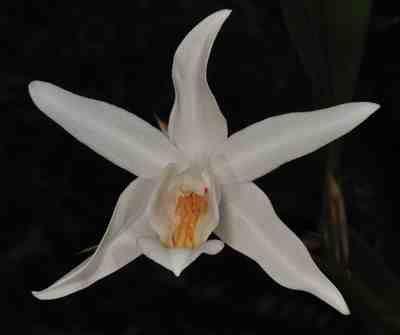Epiphyte. Pseudo-bulbs small, ovoid-globose, attached 1 to 2 cm apart on very thin naked rhizome. Leaf solitary, oblanceolate, obtuse, obliquely notched, narrowed to the base, sessile, 3 to 5 long and around 1.5 cm in width. Scape shorter or as long as the leaves, sub erect, with two sheathing bracts and at the apex a radiating umbel of 10 to 15 beautiful flowers. Flowers are of pale brownish green base with reddish brown to dark purple spots and veins. The dorsal sepal is greenish brown with five dark purple veins and a few spots of the same colour, the lateral sepals are greenish brown with numerous spots and markings of various shades of reddish brown. Petals are rather with darker shade than the sepals and with three dark purple veins and numerous spots. The lip is of brownish yellow base and with purple spots and fine margin of the same shade. Both the dorsal sepal and petals are with purple coloured marginal cilia. The dorsal sepals are small, free from the lateral pair at its base, concave, lying over the column, ovate-acute, the tip with several soft hairs on its edges. The lateral pair, much longer than the dorsal, 3 to 4 times, narrowly oblong, very blunt, sub-falcate, coherent. Petals ovate, sub-acute, with very oblique bases, the edges ciliate. Lip broadly ovate at the base much narrowed in the anterior half, the apex obtuse, the edges entire.

The Pursuit
Another interesting species of the region. Never ever thought I will come across it with such ease. I and one of my close friend, who came all the way from Delhi were camping on the banks of a small stream. He came to the hills only to enjoy a few nights of “tent stay” under the open sky. We were on a casual walk on the first evening of our stay looking for some fallen woods, so as to make a camp fire in the evening. Walked through the right bank of the stream for some meters and crossed the knee high waters on top of a fallen tree to the other side. Collected some fire wood and took the same path back. My friend with some wood logs on his hand was not able to balance his way back over the fallen tree and crossed the knee high waters through the stream. I crossed the stream first and asked him to pose for a photograph holding the logs while inside the waters. I clicked few pics and went to him to collect his mobile, so that a few pics can also be clicked on his mobile. Suddenly, I spotted this species on the under side of the fallen tree, with around 20 to 25 bulbs and eight umbels of flowers. Three of them were in full bloom. In excitement I even forgot the presence my friend and the logs we collected and started documenting this flower the rest of the evening. If my friend was not there, I would have never ventured to that region on those days and would have missed this beautiful species in bloom. The fact that the entire plant population on that fallen tree will get destroyed when the water level rises in the river in the coming monsoon season made us think about replanting those rare plants to a safer place. The next day we both carefully replanted all those plants from that fallen tree to a near by tree on the same habitat. This year too, my friend came exactly on the same days of the year to see his efforts bearing new flowers in the new host tree.








